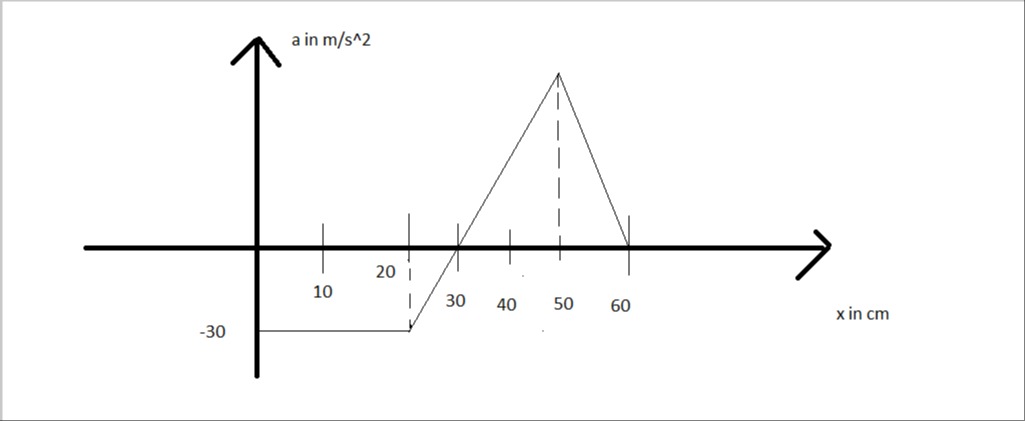Question
Question: The question is missing from the problem description. However, based on the provided a-x (accelerati...
The question is missing from the problem description. However, based on the provided a-x (acceleration-position) graph, a common problem type involves calculating the velocity of an object at a certain position, given its initial velocity. The fundamental relationship used is derived from a=vdxdv, which integrates to:
21vf2−21vi2=∫xixfadx
The integral ∫xixfadx represents the area under the a-x graph between positions xi and xf.
Analysis of the Graph: The x-axis represents position in centimeters (cm), and the y-axis represents acceleration in meters per second squared (m/s²). We must use consistent units, so we convert positions from cm to meters (1 cm = 0.01 m).
- x=0 cm = 0 m
- x=10 cm = 0.1 m
- x=20 cm = 0.2 m
- x=30 cm = 0.3 m
- x=40 cm = 0.4 m
- x=50 cm = 0.5 m
- x=60 cm = 0.6 m
The graph can be divided into three segments:
-
From x=0 m to x=0.2 m: The acceleration is constant at a=−30 m/s². Area 1 = Base × Height = (0.2−0)×(−30)=0.2×(−30)=−6.0 m2/s2.
-
From x=0.2 m to x=0.4 m: The acceleration changes linearly from a=−30 m/s² to a=0 m/s². This forms a trapezoid. Area 2 = 21(sum of parallel sides)×height (change in x) Area 2 = 21(−30+0)×(0.4−0.2)=21(−30)×0.2=−15×0.2=−3.0 m2/s2.
-
From x=0.4 m to x=0.6 m: This segment forms a triangle with its base on the x-axis. The acceleration is 0 at x=0.4 m and x=0.6 m. The peak of the triangle is at x=0.5 m. The value of the peak acceleration is not explicitly given. Let's assume the peak acceleration is +30 m/s² for illustrative purposes. Area 3 = Area of triangle = 21×base×height Area 3 = 21×(0.6−0.4)×30=21×0.2×30=0.1×30=3.0 m2/s2.
Hypothetical Question and Solution: Let's assume the question is: "An object starts from rest (vi=0) at xi=0. What is its velocity at xf=40 cm (0.4 m)?"
Using the formula: 21vf2−21vi2=∫xixfadx 21vf2−0=Area from x=0 to x=0.4 m The total area from x=0 to x=0.4 m is Area 1 + Area 2 = −6.0+(−3.0)=−9.0 m2/s2.
So, 21vf2=−9.0 m2/s2. vf2=−18.0 m2/s2.
This result yields an imaginary velocity, which is physically impossible for a real object. This indicates that if the object starts from rest at x=0, it cannot reach x=0.4 m under the described acceleration profile, or the problem statement/graph implies conditions that prevent it.
If the question were about work done, for an object of mass m: Work Done W=m×∫adx. For example, if m=1 kg and the question asked for work done from x=0 to x=0.4 m: W=1 kg×(−9.0 m2/s2)=−9.0 Joules.

The question is missing. Without the specific question, the answer cannot be determined. If we assume a question like "Find the velocity at x=40 cm starting from rest, with peak acceleration +30 m/s²", the result is physically impossible (v2=−18 m²/s²).
Solution
The change in kinetic energy is equal to the area under the a-x graph: Δ(21mv2)=m∫adx. For velocity, Δ(21v2)=∫adx. Calculate the area under the given a-x graph between the initial and final positions. Convert units to be consistent (e.g., meters for position). Use 21vf2−21vi2=Area to find the final velocity. If the result for vf2 is negative, it implies a physically impossible scenario under the given conditions, meaning the object cannot reach that position starting from rest.
